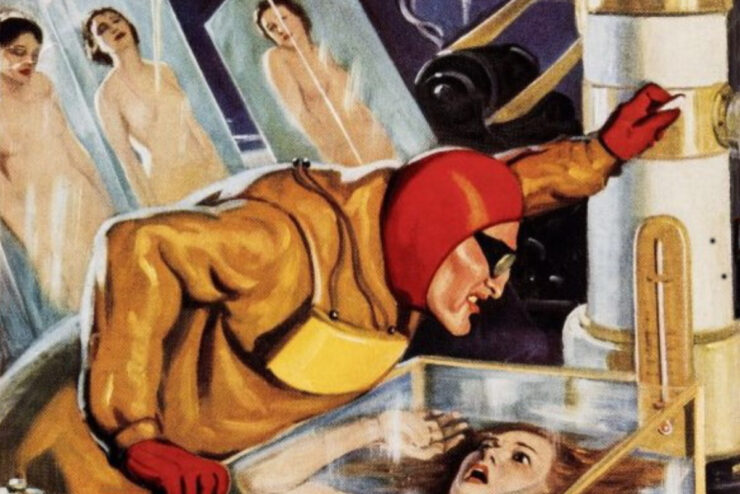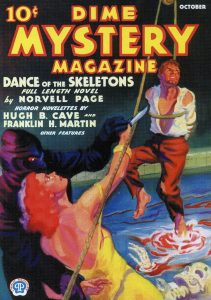 In Mars, Pennsylvania — home to PulpFest 2025 — there’s a chill in the air. Halloween is here. It’s time to shudder!
In Mars, Pennsylvania — home to PulpFest 2025 — there’s a chill in the air. Halloween is here. It’s time to shudder!
The weird-menace or shudder pulps were born when Harry Steeger of Popular Publications decided to try something new with Dime Mystery Book Magazine. Inspired by the Grand Guignol Theater of Paris, Steeger dropped the “Book” from the magazine’s title and the rather routine “two-dollar novels” from the contents. He substituted a short novel, a few novelettes, and several shuddery short stories written by his regular contributors.
The cover art was turned over to the “King of the Pulp Artists,” Walter M. Baumhofer. Inside its covers, the Popular pulp featured authors such as Hugh B. Cave, John H. Knox, Franklin H. Martin, and Norvell Wooten Page, who penned the first weird menace novella, “Dance of the Skeletons.” It was the lead story in the October 1933 number of Dime Mystery Magazine, the first “shudder pulp.”
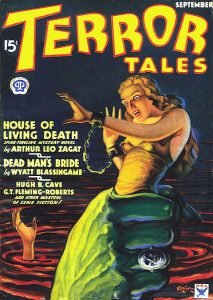 Filled with the purplest of prose in stories such as “The Graveless Dead” and “The Monster in the Dark,” the retooled Dime Mystery Magazine was an instant hit. Within a year, Steeger and his partner, Harold Goldsmith, trotted out a pair of companion magazines. Terror Tales debuted with its September 1934 issue while Horror Stories hit the stands with its January 1935 number. Both sold briskly and the shudder pulp explosion was underway!
Filled with the purplest of prose in stories such as “The Graveless Dead” and “The Monster in the Dark,” the retooled Dime Mystery Magazine was an instant hit. Within a year, Steeger and his partner, Harold Goldsmith, trotted out a pair of companion magazines. Terror Tales debuted with its September 1934 issue while Horror Stories hit the stands with its January 1935 number. Both sold briskly and the shudder pulp explosion was underway!
It didn’t take long for the competition to notice the success of the Popular weird-menace trio. Harry Donenfeld’s Culture Publications launched Spicy Mystery Stories in the spring of 1935 while Ned Pines’ Thrilling Mystery debuted in the fall of the same year. Steeger himself tried to launch Thrilling Mysteries, but Standard put a kibosh to that! The two publishers settled out of court.
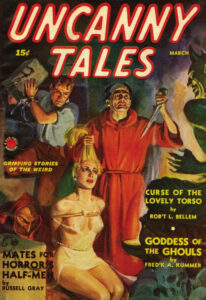 In between, Martin Goodman’s Star Detective mixed crime yarns with weird-horror as did A. A. Wyn’s Ten Detective Aces.
In between, Martin Goodman’s Star Detective mixed crime yarns with weird-horror as did A. A. Wyn’s Ten Detective Aces.
Both publishers would later launch their own short-lived shudder pulps. Goodman added Mystery Novels and Short Stories, Mystery Tales, Uncanny Tales, and other titles to his stable of magazines. Wyn would publish Ace Mystery Magazine, Eerie Mysteries, and Eerie Stories. Most of these titles didn’t make it to the 1940s.
In “Pulp Horrors of the Dirty Thirties,” writer, anthologist, and 1990 Lamont Award winner Don Hutchison observes:
The so-called “shudder” or “weird-menace” titles were a blood-red splash of color in the grey days of the Great Depression. . . . In their nightmare universe, it was always a dark and stormy night. Tethered damsels suffered in the clutches of fiends such as hell-mad surgeons, warped scientists, and masked and cowled cultists, eagerly abetted by legions of demented dwarfs and horny hunchbacks. They stripped, whipped, and boiled their curvaceous victims with the enthusiasm of medieval inquisitors. Even the requisite rock-jawed heroes of these stories suffered a purgatory of horrors in order to rescue their brutally treated fair maidens.
As the terrors and horrors mounted, so did the backlash. Reform groups such as the National Organization for Decency in Literature began to pressure news dealers to stop selling magazines they deemed vulgar. The United States Post Office Department was lobbied to deny second-class mailing rates to publishers of risqué magazines. Big city mayors threatened newsdealers with the loss of their licenses if they continued to sell “objectionable magazines.”
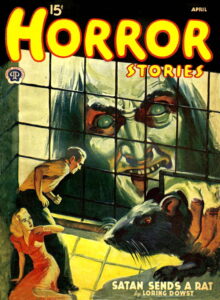 With their point-of-purchase sales and mailing privileges threatened, publishers retrenched. By 1940, Standard had turned Thrilling Mystery into a conventional mystery and detective magazine. Eventually, it would become something of a single-character pulp, featuring G. T. Fleming-Roberts’ George Chance, also known as The Green Ghost. Later, it would briefly house The Masked Detective before it became Thrilling Mystery Novel Magazine.
With their point-of-purchase sales and mailing privileges threatened, publishers retrenched. By 1940, Standard had turned Thrilling Mystery into a conventional mystery and detective magazine. Eventually, it would become something of a single-character pulp, featuring G. T. Fleming-Roberts’ George Chance, also known as The Green Ghost. Later, it would briefly house The Masked Detective before it became Thrilling Mystery Novel Magazine.
Harry Donenfeld’s Culture Publications converted their “Spicy” books into the “Speed” line of magazines at the end of 1942. As the new year dawned, Speed Mystery was introduced by the renamed Trojan Publishing. Its cover sported a fully clothed woman menaced by a man garbed in black. Granted, one can still see the girl’s alabaster skin through the sheer gown she is wearing. However, there’s no sign of the “beginning of the cleft between her gloriously swelling breasts.”
In 1941, Popular shut down both Horror Stories and Terror Tales, while Dime Mystery Magazine was retooled yet again. A May 1941 editorial announced, “Not until this issue have we been able to give you a full 100 percent sample of the magazine we always knew Dime Mystery could become.”
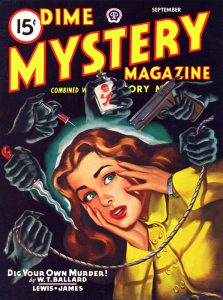 Now a bi-monthly, Dime Mystery was transformed into a fairly pedestrian mystery and detective magazine. While some yarns continued to feature a hint of the supernatural or a strange villain, gone were the truly shuddersome stories of the middle thirties. With its November 1944 number, the pulp was combined with 10 Story Mystery Magazine, a relatively short-lived title published by Popular’s cut-rate subsidiary, Fictioneers, Inc. Dime Mystery soldiered on until 1950 when it became 15 Mystery Stories. Afterward, it lasted for five more issues.
Now a bi-monthly, Dime Mystery was transformed into a fairly pedestrian mystery and detective magazine. While some yarns continued to feature a hint of the supernatural or a strange villain, gone were the truly shuddersome stories of the middle thirties. With its November 1944 number, the pulp was combined with 10 Story Mystery Magazine, a relatively short-lived title published by Popular’s cut-rate subsidiary, Fictioneers, Inc. Dime Mystery soldiered on until 1950 when it became 15 Mystery Stories. Afterward, it lasted for five more issues.
Again, Don Hutchison . . .
Pulp fiction’s bloody reign of terror had ended, not with a bang but with a whimper. Unfortunately, in discarding key ingredients of their appeal, the magazines failed to develop new innovations, much less new readers. And, with the coming of World War II, the extent of human madness and misery could no longer be viewed – much less enjoyed – as mere fiction. In a more innocent time, it was thought that the brand of horror perpetrated by the fiends of the shudder pulps was purely imaginary. Now people knew that such things – and worse – were possible.
Happy Halloween from PulpFest! We hope to see you August 7 – 10 in Mars, Pennsylvania for PulpFest 2025!
Our featured image is excerpted from John Newton Howitt’s cover art for the August/September 1937 issue of Horror Stories. Howitt’s painting later adorned the cover for the February 1940 number of Startling Mystery Magazine, a very short-lived shudder pulp from Popular Publications. It lasted for just two issues.
Our lead image is the first weird-menace pulp, the October 1933 number of Dime Mystery Magazine, featuring cover art by Walter M. Baumhofer.
Rudolph Zirm contributed the cover art for the first issue of Terror Tales, dated September 1934. Zirm also painted the cover art for the final number of Horror Stories, dated April 1941. Both magazines were published by Steeger and Goldsmith’s Popular Publications.
Uncanny Tales was one of several weird-menace pulps published by Martin Goodman, the man who started Marvel Comics. J. W. Scott painted the cover art for the May 1940 number, the fourth of five issues of the Red Circle pulp magazine.
In 1941, Popular Publications converted Dime Mystery Magazine into a mystery and detective magazine. Our final image — the work of Gloria Stoll-Karn — is the cover for the September 1946 issue of Dime Mystery Magazine Combined with Ten Story Mystery.
Visit our YouTube Channel for Happy “Savage” Halloween! and other Halloween Horrors!
And don’t forget to subscribe.
A fan of horror and fantasy fiction, Jeanne Harding attended her first PulpFest in 2023, helping us celebrate the centennial of Weird Tales. This is the weird fiction fan’s 7th contribution to our website.

